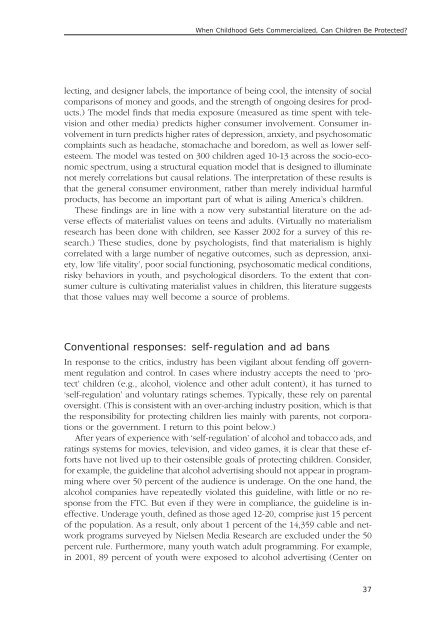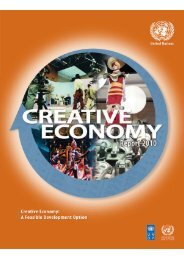In the Service of Young People? Studies and Reflections on Media ...
In the Service of Young People? Studies and Reflections on Media ...
In the Service of Young People? Studies and Reflections on Media ...
- No tags were found...
You also want an ePaper? Increase the reach of your titles
YUMPU automatically turns print PDFs into web optimized ePapers that Google loves.
When Childhood Gets Commercialized, Can Children Be Protected?lecting, <str<strong>on</strong>g>and</str<strong>on</strong>g> designer labels, <str<strong>on</strong>g>the</str<strong>on</strong>g> importance <str<strong>on</strong>g>of</str<strong>on</strong>g> being cool, <str<strong>on</strong>g>the</str<strong>on</strong>g> intensity <str<strong>on</strong>g>of</str<strong>on</strong>g> socialcomparis<strong>on</strong>s <str<strong>on</strong>g>of</str<strong>on</strong>g> m<strong>on</strong>ey <str<strong>on</strong>g>and</str<strong>on</strong>g> goods, <str<strong>on</strong>g>and</str<strong>on</strong>g> <str<strong>on</strong>g>the</str<strong>on</strong>g> strength <str<strong>on</strong>g>of</str<strong>on</strong>g> <strong>on</strong>going desires for products.)The model finds that media exposure (measured as time spent with televisi<strong>on</strong><str<strong>on</strong>g>and</str<strong>on</strong>g> o<str<strong>on</strong>g>the</str<strong>on</strong>g>r media) predicts higher c<strong>on</strong>sumer involvement. C<strong>on</strong>sumer involvementin turn predicts higher rates <str<strong>on</strong>g>of</str<strong>on</strong>g> depressi<strong>on</strong>, anxiety, <str<strong>on</strong>g>and</str<strong>on</strong>g> psychosomaticcomplaints such as headache, stomachache <str<strong>on</strong>g>and</str<strong>on</strong>g> boredom, as well as lower selfesteem.The model was tested <strong>on</strong> 300 children aged 10-13 across <str<strong>on</strong>g>the</str<strong>on</strong>g> socio-ec<strong>on</strong>omicspectrum, using a structural equati<strong>on</strong> model that is designed to illuminatenot merely correlati<strong>on</strong>s but causal relati<strong>on</strong>s. The interpretati<strong>on</strong> <str<strong>on</strong>g>of</str<strong>on</strong>g> <str<strong>on</strong>g>the</str<strong>on</strong>g>se results isthat <str<strong>on</strong>g>the</str<strong>on</strong>g> general c<strong>on</strong>sumer envir<strong>on</strong>ment, ra<str<strong>on</strong>g>the</str<strong>on</strong>g>r than merely individual harmfulproducts, has become an important part <str<strong>on</strong>g>of</str<strong>on</strong>g> what is ailing America’s children.These findings are in line with a now very substantial literature <strong>on</strong> <str<strong>on</strong>g>the</str<strong>on</strong>g> adverseeffects <str<strong>on</strong>g>of</str<strong>on</strong>g> materialist values <strong>on</strong> teens <str<strong>on</strong>g>and</str<strong>on</strong>g> adults. (Virtually no materialismresearch has been d<strong>on</strong>e with children, see Kasser 2002 for a survey <str<strong>on</strong>g>of</str<strong>on</strong>g> this research.)These studies, d<strong>on</strong>e by psychologists, find that materialism is highlycorrelated with a large number <str<strong>on</strong>g>of</str<strong>on</strong>g> negative outcomes, such as depressi<strong>on</strong>, anxiety,low ‘life vitality’, poor social functi<strong>on</strong>ing, psychosomatic medical c<strong>on</strong>diti<strong>on</strong>s,risky behaviors in youth, <str<strong>on</strong>g>and</str<strong>on</strong>g> psychological disorders. To <str<strong>on</strong>g>the</str<strong>on</strong>g> extent that c<strong>on</strong>sumerculture is cultivating materialist values in children, this literature suggeststhat those values may well become a source <str<strong>on</strong>g>of</str<strong>on</strong>g> problems.C<strong>on</strong>venti<strong>on</strong>al resp<strong>on</strong>ses: self-regulati<strong>on</strong> <str<strong>on</strong>g>and</str<strong>on</strong>g> ad bans<str<strong>on</strong>g>In</str<strong>on</strong>g> resp<strong>on</strong>se to <str<strong>on</strong>g>the</str<strong>on</strong>g> critics, industry has been vigilant about fending <str<strong>on</strong>g>of</str<strong>on</strong>g>f governmentregulati<strong>on</strong> <str<strong>on</strong>g>and</str<strong>on</strong>g> c<strong>on</strong>trol. <str<strong>on</strong>g>In</str<strong>on</strong>g> cases where industry accepts <str<strong>on</strong>g>the</str<strong>on</strong>g> need to ‘protect’children (e.g., alcohol, violence <str<strong>on</strong>g>and</str<strong>on</strong>g> o<str<strong>on</strong>g>the</str<strong>on</strong>g>r adult c<strong>on</strong>tent), it has turned to‘self-regulati<strong>on</strong>’ <str<strong>on</strong>g>and</str<strong>on</strong>g> voluntary ratings schemes. Typically, <str<strong>on</strong>g>the</str<strong>on</strong>g>se rely <strong>on</strong> parentaloversight. (This is c<strong>on</strong>sistent with an over-arching industry positi<strong>on</strong>, which is that<str<strong>on</strong>g>the</str<strong>on</strong>g> resp<strong>on</strong>sibility for protecting children lies mainly with parents, not corporati<strong>on</strong>sor <str<strong>on</strong>g>the</str<strong>on</strong>g> government. I return to this point below.)After years <str<strong>on</strong>g>of</str<strong>on</strong>g> experience with ‘self-regulati<strong>on</strong>’ <str<strong>on</strong>g>of</str<strong>on</strong>g> alcohol <str<strong>on</strong>g>and</str<strong>on</strong>g> tobacco ads, <str<strong>on</strong>g>and</str<strong>on</strong>g>ratings systems for movies, televisi<strong>on</strong>, <str<strong>on</strong>g>and</str<strong>on</strong>g> video games, it is clear that <str<strong>on</strong>g>the</str<strong>on</strong>g>se effortshave not lived up to <str<strong>on</strong>g>the</str<strong>on</strong>g>ir ostensible goals <str<strong>on</strong>g>of</str<strong>on</strong>g> protecting children. C<strong>on</strong>sider,for example, <str<strong>on</strong>g>the</str<strong>on</strong>g> guideline that alcohol advertising should not appear in programmingwhere over 50 percent <str<strong>on</strong>g>of</str<strong>on</strong>g> <str<strong>on</strong>g>the</str<strong>on</strong>g> audience is underage. On <str<strong>on</strong>g>the</str<strong>on</strong>g> <strong>on</strong>e h<str<strong>on</strong>g>and</str<strong>on</strong>g>, <str<strong>on</strong>g>the</str<strong>on</strong>g>alcohol companies have repeatedly violated this guideline, with little or no resp<strong>on</strong>sefrom <str<strong>on</strong>g>the</str<strong>on</strong>g> FTC. But even if <str<strong>on</strong>g>the</str<strong>on</strong>g>y were in compliance, <str<strong>on</strong>g>the</str<strong>on</strong>g> guideline is ineffective.Underage youth, defined as those aged 12-20, comprise just 15 percent<str<strong>on</strong>g>of</str<strong>on</strong>g> <str<strong>on</strong>g>the</str<strong>on</strong>g> populati<strong>on</strong>. As a result, <strong>on</strong>ly about 1 percent <str<strong>on</strong>g>of</str<strong>on</strong>g> <str<strong>on</strong>g>the</str<strong>on</strong>g> 14,359 cable <str<strong>on</strong>g>and</str<strong>on</strong>g> networkprograms surveyed by Nielsen <strong>Media</strong> Research are excluded under <str<strong>on</strong>g>the</str<strong>on</strong>g> 50percent rule. Fur<str<strong>on</strong>g>the</str<strong>on</strong>g>rmore, many youth watch adult programming. For example,in 2001, 89 percent <str<strong>on</strong>g>of</str<strong>on</strong>g> youth were exposed to alcohol advertising (Center <strong>on</strong>37
















